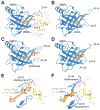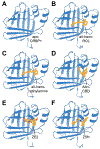Advances and therapeutic opportunities in visual cycle modulation
- PMID: 40280538
- PMCID: PMC12147667
- DOI: 10.1016/j.preteyeres.2025.101360
Advances and therapeutic opportunities in visual cycle modulation
Abstract
The visual cycle is a metabolic pathway that enables continuous vision by regenerating the 11-cis-retinal chromophore for photoreceptors opsins. Although integral to normal visual function, the flux of retinoids through this cycle can contribute to a range of retinal pathologies, including Stargardt disease, age-related macular degeneration, and diabetic retinopathy. In such conditions, intermediates and byproducts of the visual cycle, such as bisretinoid components of lipofuscin, can accumulate, concomitant with cellular damage and eventual photoreceptor loss. This has inspired efforts to modulate the visual cycle, aiming to slow or prevent the formation of these toxic intermediates and thus preserve retinal structure and function. Over the past two decades, multiple strategies to modulate the visual cycle have emerged. These include both intrinsic approaches, targeting key enzymes, retinoid-binding proteins, or receptors within the pigment epithelium or photoreceptors (e.g., RPE65, CRBP1, and rhodopsin inhibitors/antagonists) and extrinsic strategies that indirectly alter retinoid availability within the retina (e.g., RBP4 antagonists). Many of these agents have shown promise in animal models of visual cycle-associated retinal diseases, reducing pathological changes, and improving retinal survival. Several have advanced into clinical studies, although none are currently FDA-approved. Challenges remain in optimizing drug specificity and duration of action while minimizing side effects such as nyctalopia. In this review, we comprehensively examine current and emerging visual cycle modulators, discuss their medicinal chemistry, mechanisms of action, efficacy in preclinical and clinical studies, and highlight future opportunities for drug discovery aimed at safely and effectively preserving vision through modulation of this biochemical pathway.
Keywords: Drug development; Inhibitors; Ophthalmology; RPE65; Retinol-binding protein; Retinopathy; Stargardt disease; Visual cycle; Vitamin A.
Published by Elsevier Ltd.
Figures







Similar articles
-
The novel visual cycle inhibitor (±)-RPE65-61 protects retinal photoreceptors from light-induced degeneration.PLoS One. 2022 Oct 13;17(10):e0269437. doi: 10.1371/journal.pone.0269437. eCollection 2022. PLoS One. 2022. PMID: 36227868 Free PMC article.
-
Key enzymes of the retinoid (visual) cycle in vertebrate retina.Biochim Biophys Acta. 2012 Jan;1821(1):137-51. doi: 10.1016/j.bbalip.2011.03.005. Epub 2011 Apr 5. Biochim Biophys Acta. 2012. PMID: 21447403 Free PMC article. Review.
-
A non-retinoid antagonist of retinol-binding protein 4 rescues phenotype in a model of Stargardt disease without inhibiting the visual cycle.J Biol Chem. 2018 Jul 20;293(29):11574-11588. doi: 10.1074/jbc.RA118.002062. Epub 2018 Jun 5. J Biol Chem. 2018. PMID: 29871924 Free PMC article.
-
Metabolic basis of visual cycle inhibition by retinoid and nonretinoid compounds in the vertebrate retina.J Biol Chem. 2008 Apr 11;283(15):9543-54. doi: 10.1074/jbc.M708982200. Epub 2008 Jan 14. J Biol Chem. 2008. PMID: 18195010 Free PMC article.
-
Vitamin A and Vision.Subcell Biochem. 2016;81:231-259. doi: 10.1007/978-94-024-0945-1_9. Subcell Biochem. 2016. PMID: 27830507 Review.
References
-
- Ahmed CM, Dwyer BT, Romashko A, Van Adestine S, Park EH, Lou Z, Welty D, Josiah S, Savinainen A, Zhang B, Lewin AS, 2019. SRD005825 Acts as a Pharmacologic Chaperone of Opsin and Promotes Survival of Photoreceptors in an Animal Model of Autosomal Dominant Retinitis Pigmentosa. Transl. Vis. Sci. Technol 8, 30. 10.1167/tvst.8.6.30 - DOI - PMC - PubMed
-
- Akita H, Tanis SP, Adams M, Balogh-Nair V, Nakanishi K, 1980. Nonbleachable rhodopsins retaining the full natural chromophore. J. Am. Chem. Soc 102, 6370–6372. 10.1021/ja00540a047 - DOI
Publication types
MeSH terms
Substances
Grants and funding
LinkOut - more resources
Full Text Sources
Miscellaneous

